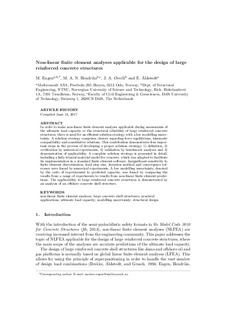| dc.contributor.author | Engen, Morten | |
| dc.contributor.author | Hendriks, Max | |
| dc.contributor.author | Øverli, Jan Arve | |
| dc.contributor.author | Åldstedt, Erik | |
| dc.date.accessioned | 2018-08-28T13:45:54Z | |
| dc.date.available | 2018-08-28T13:45:54Z | |
| dc.date.created | 2018-04-11T19:04:01Z | |
| dc.date.issued | 2017 | |
| dc.identifier.citation | European Journal of Environmental and Civil Engineering. 2017, 1-23. | nb_NO |
| dc.identifier.issn | 1964-8189 | |
| dc.identifier.uri | http://hdl.handle.net/11250/2559704 | |
| dc.description.abstract | In order to make non-linear finite element analyses applicable during assessments of the ultimate load capacity or the structural reliability of large reinforced concrete structures, there is need for an efficient solution strategy with a low modelling uncertainty. A solution strategy comprises choices regarding force equilibrium, kinematic compatibility and constitutive relations. This contribution demonstrates four important steps in the process of developing a proper solution strategy: (1) definition, (2) verification by numerical experiments, (3) validation by benchmark analyses and (4) demonstration of applicability. A complete solution strategy is presented in detail, including a fully triaxial material model for concrete, which was adapted to facilitate its implementation in a standard finite-element software. Insignificant sensitivity to finite element discretisation, load step size, iteration method and convergence tolerance were found by numerical experiments. A low modelling uncertainty, denoted by the ratio of experimental to predicted capacity, was found by comparing the results from a range of experiments to results from non-linear finite element predictions. The applicability to large reinforced concrete structures is demonstrated by an analysis of an offshore concrete shell structure. | nb_NO |
| dc.language.iso | eng | nb_NO |
| dc.publisher | Taylor & Francis | nb_NO |
| dc.title | Non-linear finite element analyses applicable for the design of large reinforced concrete structures | nb_NO |
| dc.type | Journal article | nb_NO |
| dc.type | Peer reviewed | nb_NO |
| dc.description.version | acceptedVersion | nb_NO |
| dc.source.pagenumber | 1-23 | nb_NO |
| dc.source.journal | European Journal of Environmental and Civil Engineering | nb_NO |
| dc.identifier.doi | 10.1080/19648189.2017.1348993 | |
| dc.identifier.cristin | 1578875 | |
| dc.description.localcode | This is an [Accepted Manuscript] of an article published by Taylor & Francis in [European Journal of Environmental and Civil Engineering] on [25 Jul 2017], available at https://www.tandfonline.com/doi/abs/10.1080/19648189.2017.1348993 | nb_NO |
| cristin.unitcode | 194,64,45,0 | |
| cristin.unitname | Institutt for konstruksjonsteknikk | |
| cristin.ispublished | true | |
| cristin.fulltext | postprint | |
| cristin.qualitycode | 1 | |
